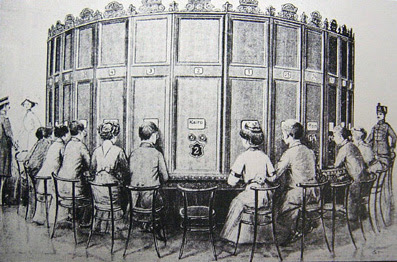Around 1880 an Austrian scientist invented a machine which allowed you to travel the world for a penny.
The Fotoplastikon sent stereoscopic photos around a circular sphere and illuminated them from behind, creating a genuine 3D impression.
 |
| The Swiss Alps - Monte Rossa, 1901 |
In times where both photography and travelling was only for the privileged few, the invention proved a huge success. By 1910 the machines operated in 250 European cities, circulating 100,000 different photos.
Since then, mass travelling and mass photography have transformed - and arguably banalised - the way we perceive the world. I didn't expect much yesterday when I went to the only remaining Fotoplastikon, operating in Warsaw since 1901. I was pleasantly surprised. The whole thing felt like a 3D journey in time, making me think that the past may itself be a precious place that we can travel to. Some may say that's just another example of the vintage fetishism that nurtures our nostalgia for things gone. So what, I say.
 |
| The Filipino Revolt, 1900 |
 |
| Dutch fishing family on the island of Markham, 1894 |
 |
| The Warsaw Opera, 1905 |


Jacek Dehnel, moj znajomy, napisal: No nie, nie, nie. Przepraszam bardzo, ale to nie jest prawda. Stereoskopii nie wymyślił Austriak ok. 1880, tylko Wheatstone w 1833 (aczkolwiek znane są rysunki stereoskopowe z XVI w.), i to nie przy pomocy fotografii, a obrazków. Pierwsze stereoskopy do zdjęć (dagerotypowe) powstawały od lat 50-tych XIX wieku. Jeśli chodzi o fotoplastikon (w sensie budki z przezroczami), to być może powstała w latach 80-tych XIX wieku w Austrii, ale to była robota nie "austriackiego naukowca" a co najwyżej austriackiego konstruktora/rzemieślnika, który posłużył się wcześniejszymi wynalazkami, powszechnie wówczas znanymi i używanymi :)
ReplyDeleteO, nawet znalazłem. Otóż już w 1866 roku na jarmarkach występował Alois Polanecky (być może Austriak) ze swoim "Salonem stereoskopowym" (25 zwykłych stereoskopów w obudowie). Ten "właściciel bud jarmarcznych" swój salon skonstruował z pomocą francuskiego optyka. Jego patent udoskonalił August Fuhrmann, który w1880 roku pokazywał fotoplastykon w Breslau.
dziekuje bardzo za pouczenie, drd. Zmienie to.
Deletelooks like fun. maybe manda and me can go see times gone by too!
ReplyDelete